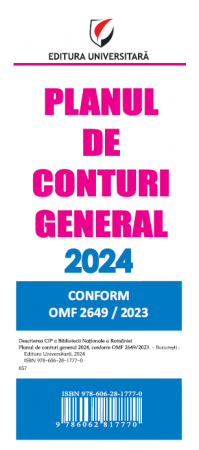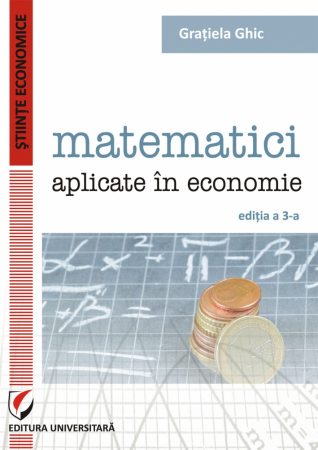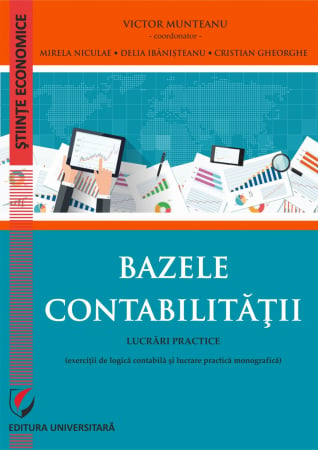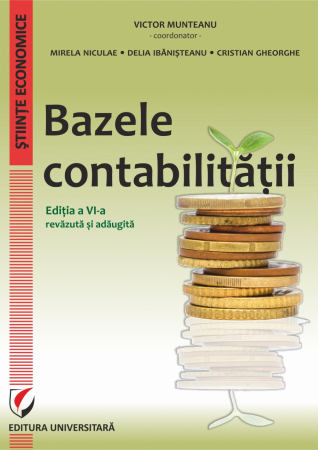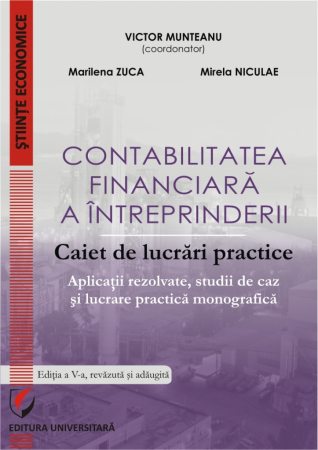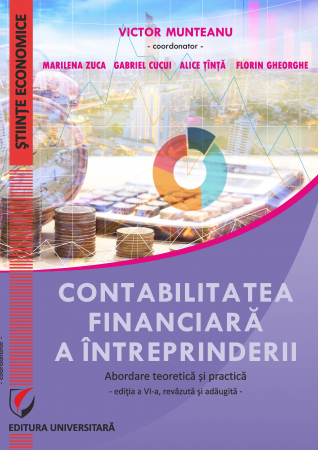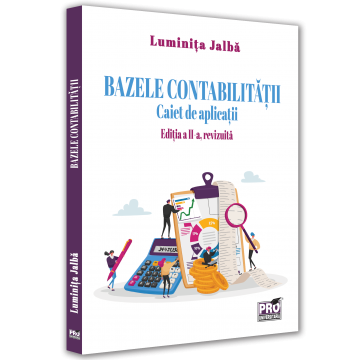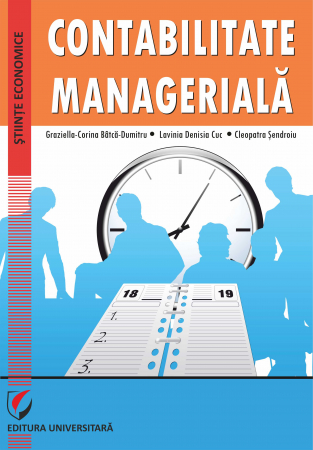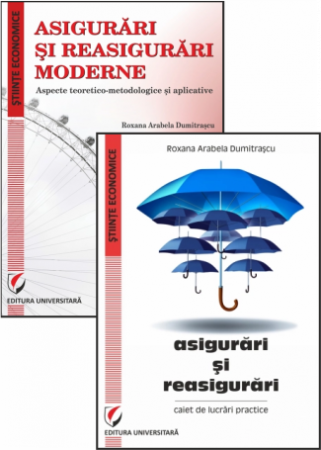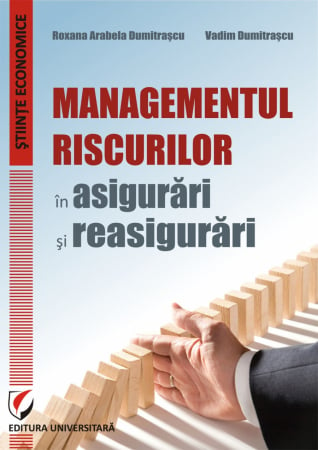ISBN: 978-606-28-0191-5
DOI: 10.5682/9786062801915
Publisher year: 2015
Edition: I
Pages: 288
Publisher: Editura Universitară
Author: Vadim Dumitrascu, Roxana Arabela Dumitrascu
- Description
- Download (1)
- Authors
- Content
- More details
- Reviews (0)
The general objective of financial management refers to maximizing the market value of the company. By achieving this objective, the initial investment in the business, made by the company's shareholders, is justified from a financial point of view. To meet it, management must identify and select those investment opportunities that generate the most consistent flows of economic value. From this perspective, the entire company represents a portfolio of previous investments on the basis of which the current economic patrimony of the company was created, as an expression of its potential for growth and competitiveness. But discovering investment possibilities and their correct substantiation is only part of the problem.
Maximizing the market value of the company takes place when investment decisions are perfectly harmonized with the evolutions of the other important financial dimensions and perfectly integrated in the strategic context of the company. This is the vision on investment management that we promote in this paper.
-
Managementul investitiilor. Abordari teoretice si instrumente aplicative
Download
Education:
Faculty of Economics, University "Petre Andrei" of Iasi, specializing in Finance and Accounting (2001);
Post-graduate School of the University FIBAS "Al. I. Cuza" Iasi, master's degree in Economics and Financial Management & Banking (2005);
Academy of Economic Studies (2010), PhD in Finance;
Romanian Academy, SPODE, post-doctoral studies in economics.
Activity:
2001-2011 professor at the Faculty of Economics of the University "Petre Andrei" of Iasi;
2012 Ph.D. Lecturer at the Faculty of Finance, Banking and Accounting, of Christian University "Dimitrie Cantemir" of Bucharest, owner of enterprise financial management courses, insurance and reinsurance and risk management in insurance and reinsurance.
Publications:
Single author: Financial management company. Self-study manual (2012), Insurance and reinsurance. Self-study manual (2012), Prices and and competitivity. Self-study manual (2012), Management of the goodwill value (2008).
Coauthor: Intangible firm capital management (2009), Drift Management (2005), Management versus postmodernity (2005), Defiance complexity (2004), Elements of evaluating companies (2002).
Over 70 articles and studies published in scientific journals.
VADIM DUMITRASCU
Introduction / 9
Chapter 1
Conceptual elements regarding investments / 13
1.1. The notion of investment / 13
1.2. Types of investments at company level. Investment project / 14
1.3. Financial implications of investment decisions / 17
1.4. The role of investments in the context of the company's strategy / 26
Chapter 2
The structure of the investment process at company level / 30
2.1. The phases of the investment process / 30
2.2. Activities that form the investment process / 33
2.3. Investment project programming / 36
2.4. Risk assessment and control in investment projects / 42
Chapter 3
Implications of cash flow in substantiating investments / 61
3.1. Economic results as a source of funds for the company / 61
3.2. Cash flow - a multi-referential notion / 64
3.3. Cash flow as a measure of the quality of the company's financial balance / 69
3.4. The company's cash flow destinations / 71
3.5. Relevance of profitability in estimating investment performance / 74
3.6. The impact of self-financing on cash flow / 78
3.7. Elasticity of self-financing / 81
3.8. Selecting the appropriate form of cash flow to substantiate the investment / 85
3.9. Cash flow generated by intangible assets (goodwill) / 87
Chapter 4
The impact of investments on the main financial dimensions of the company / 90
4.1. The influence of investments on the creation of added economic value / 90
4.2. The correlation between investments and the financial viability of the company / 97
4.3. The effects of investments on the value of the company / 104
4.4. The impact of investments on the financial structure of the company / 113
Chapter 5
Incidence of investments on the patrimonial value of the company / 116
5.1. The meanings of the value concept of the company / 116
5.2. Factors influencing the value of the company / 118
5.3. Net accounting assets (ANC) / 121
5.4. Adjusted net book assets (ANCC) / 122
5.5. Substantial values of the company / 129
5.6. Permanent capitals necessary for operation / 130
Chapter 6
Investment relationship - profitability (yield) value of the company / 131
6.1. The concept of profitability (yield) value of the company / 131
6.2. The multitude of company profitability values / 134
6.3. Company evaluation by updating cash flows / 136
Chapter 7
The role of investments in the process of financial recovery of companies in difficulty / 147
7.1. Symptoms of financial difficulties at company level / 147
7.2. Financial aspects of the company restructuring process / 149
7.3. Content and phases of the company's financial recovery process / 153
7.4. Financial criteria of the companies' recovery process / 158
7.5. Peculiarities of the evaluation of companies in difficulty / 162
7.6. Methodological perspectives regarding the evaluation of economically viable and deficient activities / 169
7.7. The role of intangible assets generating goodwill in the strategic positioning of the company / 174
7.8. The "levers" of restructuring and goodwill / 178
Chapter 8
The relationship between investments and the company's goodwill / 184
8.1. The meanings and implications of the goodwill concept of the company / 184
8.2. Traditional techniques for calculating the company's goodwill / 186
8.3. The effects of goodwill on the global value of the company / 193
8.4. The use of goodwill as a criterion for substantiating investments / 198
8.5. The company's investments: between the minimum functionality and the maximum competitiveness / 203
Chapter 9
Incidence of intangible investments on economic competitiveness / 210
9.1. Intangible investments as a foundation of the knowledge economy / 210
9.2. The specificity of intangible investments / 216
9.3. Intangible investments in the equation of economic growth / 221
9.4. The impact of intangible investments on development orientation / 226
9.5. The relationship between the accumulation of intangible capital and the increase of economic performance / 227
9.6. The process of intangible capital formation / 230
Chapter 10
The investment strategy of the company / 233
10.1. Investment strategies at company level / 233
10.2. The concept of the strategic value of the company: causes, implications, effects / 248
10.3. Methodological benchmarks regarding a strategic model based on goodwill / 253
Chapter 11
Investment process simulation and forecasting tools / 260
11.1. Basic notions regarding the simulation of investment processes / 260
11.2. Negative reverse connection of order I (CIN I) and order II (CIN II) / 262
11.3. Positive inverse connection (CIP) / 267
11.4. Coupling and nonlinearity of inverse connections / 269
11.5. Fundamentals of investment forecasting / 274
11.6. Investment forecast based on dynamic economic assets / 280
11.7. Net effective value of investment (VEN) / 283
Selective bibliography / 285
The general objective of financial management refers to maximizing the market value of the company. By achieving this objective, the initial investment in the business, made by the company's shareholders, is justified from a financial point of view. To meet it, management must identify and select those investment opportunities that generate the most consistent flows of economic value. From this perspective, the entire company represents a portfolio of previous investments on the basis of which the current economic patrimony of the company was created, as an expression of its potential for growth and competitiveness. But discovering investment possibilities and their correct substantiation is only part of the problem.
Maximizing the market value of the company takes place when investment decisions are perfectly harmonized with the evolutions of the other important financial dimensions and perfectly integrated in the strategic context of the company. This is the vision on investment management that we promote in this paper.
Chapter 1 addresses the general elements associated with the investment concept: the investment project, the financial dimensions of investment efficiency, as well as the traditional and current methods of substantiation and selection of investments. Chapter 2 undertakes a thorough analysis of the structure of the investment process at company level: the specific stages of this process and their content, the tools and techniques for programming the investment project and risk management in investment projects.
Chapter 3 is devoted to cash flow as an essential element of economic-financial substantiation of the investment. Thus, the differences and interdependencies between the economic results obtained by the company and its treasury are systematically analyzed as factors that condition the occurrence of cash flow. Furthermore, the complexity and multidimensionality of the cash-flow concept is subject to attention. The central idea of the chapter refers to the fact that the most suggestive image of the financial balance is found in the size of the company's cash flow.
Also, attention is drawn to the multitude of destinations that cash flow can have, investments being only one of them. Arguably, the question is whether profitability is a reliable measure of investment performance, and self-financing capacity is approached as a special form of cash flow. The last aspect raises the issue of determining the sensitivity of self-financing in relation to changes in the volume of activity of the company. The chapter ends with the presentation of a model for choosing the type of cash flow for substantiating investments.
Chapter 4 is subject to critical examination of the impact of investments on the main financial dimensions of the company. In this way, the inextricable and complex connection between investments and the process of creating the added economic value is followed. Among the effects and implications generated by investments is highlighted the relationship between investment and financial viability, the latter being seen as a measure of the company's ability to be simultaneously profitable and financially balanced. These aspects clearly highlight the impact of investments on the value of the company.
Continuing the analytical approach initiated in the previous chapter, chapter 5 focuses on the relationship between investments and the patrimonial value of the company. After examining the multireferential character of the company's value concept, the main internal and external factors for forming this value are presented. The net accounting asset and the corrected net accounting asset represent the main forms of the patrimonial value of a business, and the substantial values and the permanent capitals necessary for the exploitation are considered as specific forms of the economic patrimony. The relationship between investment and return value is the subject of Chapter 6. After resuming some fundamental considerations regarding the return value of the company and the main types of this value, the author's attention focuses on updating cash flows as an essential way to determine the return value.
Chapter 7 follows the implications of investments on the management of companies in financial difficulty. The manifestations of financial difficulties and their causes are presented. In this context, a special place is dedicated to the financial dimensions of the restructuring / recovery of companies in difficulty. The process of financial recovery of companies and the landmarks of this process are key elements of the chapter. Establishing the value of companies in difficulty is, therefore, the essential aspect of recovery management, highlighting the role of investments. The chapter ends with the presentation of a set of considerations and principles for evaluating viable and financially deficient activities.
Chapter 8 focuses on the interdependencies between investments and the company's goodwill - the surplus of global value over the patrimonial value, which the company can create by controlling intangible assets. After reviewing the classical methods of calculating goodwill, its impact on the global value of the company is analyzed based on the so-called "differential profitability" generating overprofit and, therefore, over-value for the business. Goodwill is presented as an excellent tool for substantiating and selecting investments.
In accordance with the main theses from the previous chapter, in chapter 9 is developed the relationship between the economic competitiveness of companies and territories, on the one hand, and investments in the creation and consolidation of intangible assets, on the other hand. The importance of this relationship is amplified as the knowledge-based economy consolidates and asserts itself. Given these, the economic and financial characteristics of intangible investments are described and their values presented as a catalyst for economic growth in modern economies. It is argued that the developmental orientation of a country or company is imprinted by the attention paid to intangible investments, between the accumulation of intangible capital and economic performance there are certain and strong connections.
Chapter 10 addresses investment strategies at the company level. The following investment strategy models are analyzed - the enterprise life cycle model, business portfolio optimization models, investment optimization models, financial structure optimization models and company economic value maximization models. The strategic value of the company is presented as a concept that allows the achievement of a fine delimitation between differentiated investment perspectives. Chapter 11 focuses on the possibilities of simulation and forecasting of investment processes. In this sense, a special role is reserved for the concepts of dynamic economic asset and net effective value of the investment.
The paper is intended for all those interested in the concepts, tools, and models that derive from a holistic and systemic vision of investment management in particular and the financial management of the company in general.

6359.png)
![Investment Management. Theoretical Approaches and Applied Tools [1] Investment Management. Theoretical Approaches and Applied Tools [1]](https://gomagcdn.ro/domains/editurauniversitara.ro/files/product/large/managementul-investitiilor-abordari-teoretice-si-instrumente-aplicative-831-459929.jpg)
